“Travel far, pay no fare…a book can take you anywhere.”
Anne Morrow Lindbergh
Part 1: A Trip across the U.S.A
Many Americans are woefully ignorant of geography. Almost three-quarters of eighth grade students tested below proficient in geography on the 2014 National Assessment of Educational Progress – also known as the Nation’s Report Card. In a report to a Senate subcommittee, data showed eighth grade teachers spend less than 10% of their social studies instruction on geography, and most states don’t require a course in geography in middle school or high school (GAO, October, 2015). When the assessment was administered again in 2018, students scored even lower (The Nation’s Report Card, 2018).
In his 2009 Caldecott Honor book How I Learned Geography, young Uri Shulevitz explored the world through a large wall map. With GPS embedded in our phones and cars, maps may seem obsolete today. But might every classroom, library, and home benefit from having maps and globes prominently displayed? Traveling is one way to learn geography. But if we can’t actually travel the world, we can visit places through books. Many picture books have anonymous settings, but some include authentic landmarks identifying locations that can be pinpointed on a map. Traveling from west coast to east coast, several Caldecott Award books feature settings in the United States, and we can become armchair travelers through the illustrations.
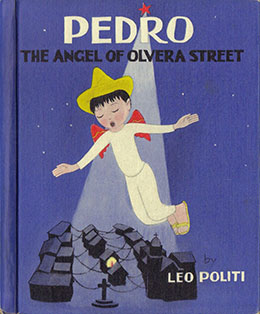
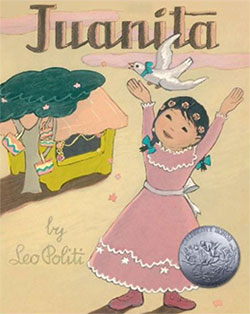
We begin our travels in Los Angeles on Olvera Street, the setting for Leo Politi’s Pedro, the Angel of Olvera Street, a 1947 Caldecott Honor book in which Pedro leads the Christmas procession La Posada. Olvera Street is also the setting of Politi’s 1949 Caldecott Honor book Juanita, in which Juanita participates in the Blessing of the Animals ceremony at Easter. Politi’s books were the first Caldecott Award books to feature Mexican American characters. His love for the Latino people, especially children, is reflected in his colorful tempera illustrations (ALSC, 2017). Politi and his family lived on Olvera Street (Riley, 2002). Known as the “birthplace of Los Angeles,” it is a block-long Mexican marketplace in El Pueblo Historic Park with vendor stalls, cafes, and a plaza amidst historic buildings (Trausch, n.d.). Though more modern now, Olvera Street still retains its historical charm depicted in Politi’s books. A replica of the original ornately carved wooden cross found in Pedro, the Angel of Olvera Street stands at the entrance to the street.
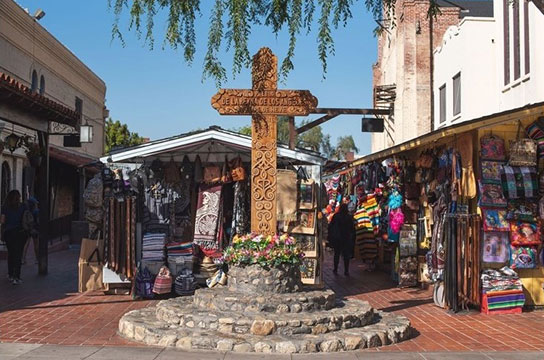
Pedro, the Angel of Olvera Street stands at the entrance to the street.
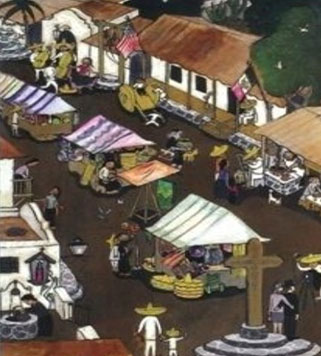
and the cross in Pedro, the Angel of Olvera Street
Near the cross, Politi’s mural “Blessing of the Animals” appears on a wall in the Biscailuz Building. Painted in acrylics between the years 1974 – 1978, Politi chose the Blessing of the Animals ceremony for the mural because he felt the parade was about children, animals and flowers, which were subjects he painted best (Several, 1998).
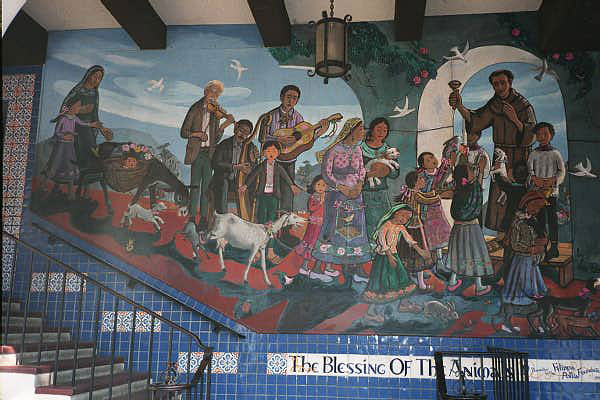
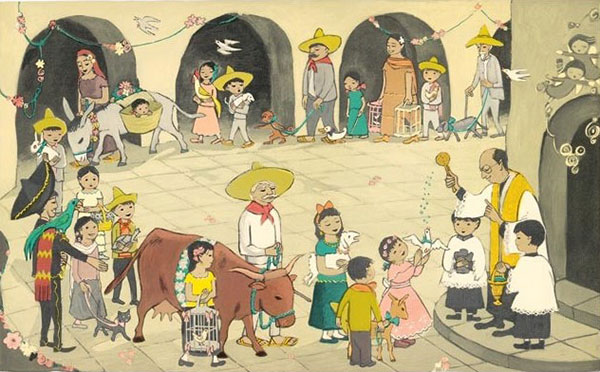
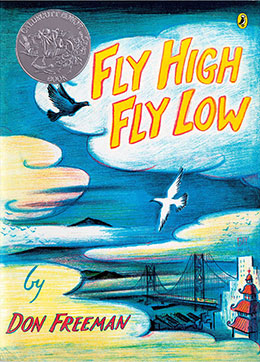 Moving up the coast of California, we reach San Francisco. Here Sid and Midge, a pigeon and a dove, nest in the lower loop of the large letter “B” of the Bay Hotel in Don Freeman’s 1958 Caldecott Honor book Fly High, Fly Low. From the vantage point of their nest high up on the building, they have a panoramic view of the city including Union Square, the iconic cable cars, and the Golden Gate Bridge. Freeman replicates the international orange color (Golden Gate Bridge, 2021) of the bridge using red, orange, and yellow colored pencils (ALSC, 2017).
Moving up the coast of California, we reach San Francisco. Here Sid and Midge, a pigeon and a dove, nest in the lower loop of the large letter “B” of the Bay Hotel in Don Freeman’s 1958 Caldecott Honor book Fly High, Fly Low. From the vantage point of their nest high up on the building, they have a panoramic view of the city including Union Square, the iconic cable cars, and the Golden Gate Bridge. Freeman replicates the international orange color (Golden Gate Bridge, 2021) of the bridge using red, orange, and yellow colored pencils (ALSC, 2017).
Viking Books for Young Readers reissued Fly High, Fly Low in 2004 (Schmitz, 2004), and Puffin Books published a 50th anniversary paperback edition in 2007.
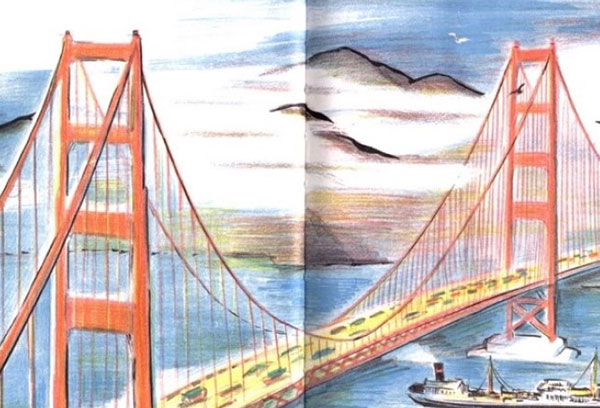
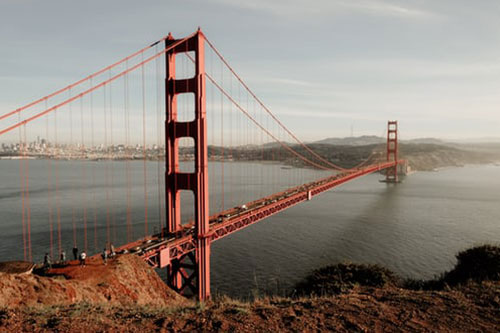
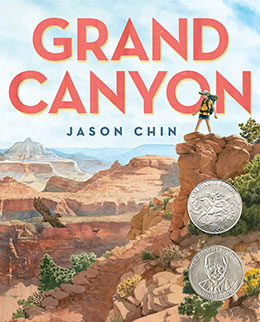 Traveling east, we arrive in Arizona’s Grand Canyon National Park. In his book Grand Canyon Jason Chin plays with time, past and present, to tell the story of a father and daughter hiking out from the Colorado River to the rim of the canyon. His note about the illustrations states, “Each illustration in this book depicts a location along specific trails and if you visit the canyon you may be able to find the very spots that I included” (Chin, 2017). The front endpapers are a map of the Colorado River snaking through the canyon. An insert on the map shows the location of the park in Arizona. The four-page gatefold panoramic view of the canyon created with “pen and ink, watercolor, and gouache” (Bird, 2017) is a satisfying conclusion to the trek. But this is more than a story of a hike. Information about the history, ecology, geology, plants, and animals of the canyon are interspersed throughout the story, on page borders, and addressed in endnotes. In addition to a 2018 Caldecott Award Honor, Chin earned a 2018 Robert Sibert Informational Book Award.
Traveling east, we arrive in Arizona’s Grand Canyon National Park. In his book Grand Canyon Jason Chin plays with time, past and present, to tell the story of a father and daughter hiking out from the Colorado River to the rim of the canyon. His note about the illustrations states, “Each illustration in this book depicts a location along specific trails and if you visit the canyon you may be able to find the very spots that I included” (Chin, 2017). The front endpapers are a map of the Colorado River snaking through the canyon. An insert on the map shows the location of the park in Arizona. The four-page gatefold panoramic view of the canyon created with “pen and ink, watercolor, and gouache” (Bird, 2017) is a satisfying conclusion to the trek. But this is more than a story of a hike. Information about the history, ecology, geology, plants, and animals of the canyon are interspersed throughout the story, on page borders, and addressed in endnotes. In addition to a 2018 Caldecott Award Honor, Chin earned a 2018 Robert Sibert Informational Book Award.
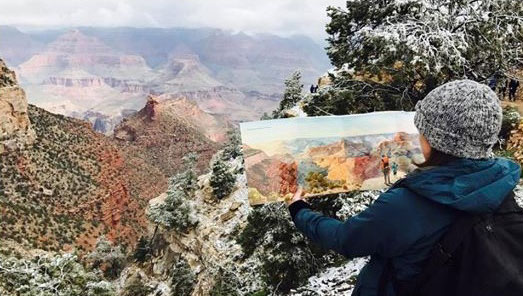
watercolor, and gouache” is a satisfying conclusion to the trek.
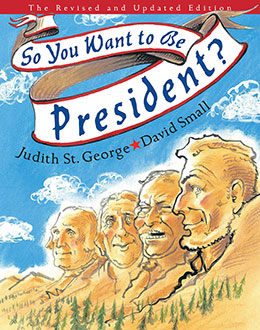 On the way to Washington, D.C. with Judith St. George and David Small’s So You Want to Be President, we pass by Mt. Rushmore in South Dakota. Washington, Jefferson, Roosevelt, and Lincoln appear more jovial on the book jacket than they do on the actual monument. The book opens with a double-page spread of Franklin and Eleanor Roosevelt enjoying tea on the lawn of the White House. Small worked as an editorial artist for the New Yorker, the New York Times, and the Washington Post (Small, 2001). His “watercolor, ink, and pastel chalk” (ALSC, 2017) illustrations reflect that cartooning style and humorously capture St. George’s entertaining facts and trivia about presidents from Washington through Clinton in this 2001 Caldecott Medal book. The book has been revised twice: once in 2004 to include George W. Bush, and again in 2012 to include Barack Obama.
On the way to Washington, D.C. with Judith St. George and David Small’s So You Want to Be President, we pass by Mt. Rushmore in South Dakota. Washington, Jefferson, Roosevelt, and Lincoln appear more jovial on the book jacket than they do on the actual monument. The book opens with a double-page spread of Franklin and Eleanor Roosevelt enjoying tea on the lawn of the White House. Small worked as an editorial artist for the New Yorker, the New York Times, and the Washington Post (Small, 2001). His “watercolor, ink, and pastel chalk” (ALSC, 2017) illustrations reflect that cartooning style and humorously capture St. George’s entertaining facts and trivia about presidents from Washington through Clinton in this 2001 Caldecott Medal book. The book has been revised twice: once in 2004 to include George W. Bush, and again in 2012 to include Barack Obama.
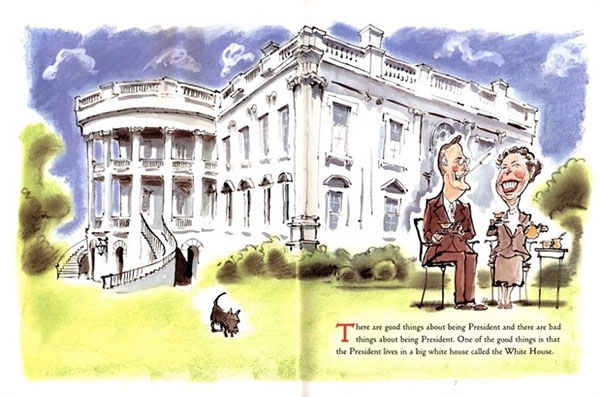
illustration © David Small, from So You Want to Be President, written by Judith St. George
From Washington, D.C. we enter New York City through the borough of Brooklyn to visit Mo Willems’ neighborhood that he depicts in his Caldecott Honor books about Trixie, her parents, and her stuffed toy Knuffle Bunny. In illustrator notes for both Knuffle Bunny: A Cautionary Tale, a 2005 Caldecott Honor, and Knuffle Bunny Too: A Case of Mistaken Identity, a 2008 Caldecott Honor, Willems describes his artwork as hand drawn ink sketches, digitally colored, melded with digital photographs of his Park Slope neighborhood shaded in sepia tones. Tourists may not find the exact locations of the laundromat or Trixie’s school, but there is no mistaking the arch in Grand Army Plaza where Trixie and her father and Sophie and her father meet late at night to exchange mixed up bunnies. You can barely see the father/daughter pairs as they approach the arch from the far left and right.
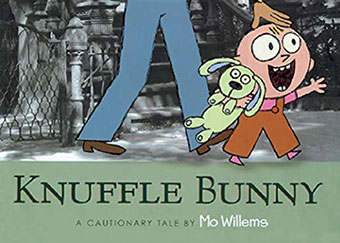
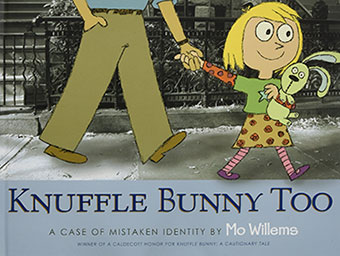
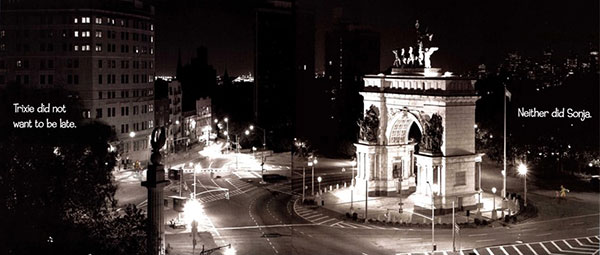
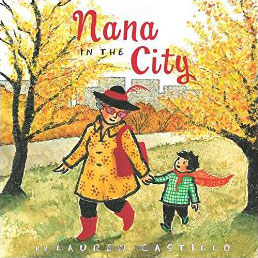 Now we cross the Brooklyn Bridge to Manhattan with a little boy who visits his grandmother in Lauren Castillo’s 2015 Caldecott Honor book Nana in the City. Castillo’s vibrant, warm watercolor images (ALSC, 2017) are outlined in bold black lines. The subway, a spacious park, and busy streets with tall buildings could be any city. Castillo never names it. But her illustrations of the Brooklyn Bridge and of the Empire State Building place this setting squarely in Manhattan.
Now we cross the Brooklyn Bridge to Manhattan with a little boy who visits his grandmother in Lauren Castillo’s 2015 Caldecott Honor book Nana in the City. Castillo’s vibrant, warm watercolor images (ALSC, 2017) are outlined in bold black lines. The subway, a spacious park, and busy streets with tall buildings could be any city. Castillo never names it. But her illustrations of the Brooklyn Bridge and of the Empire State Building place this setting squarely in Manhattan.
In interviews, Castillo said, “Cityscapes, dogs and cats are some of my favorite things to draw, so I find ways sneak them in to my art whenever possible” (Marple, 2014). Of her book about Nana, “It’s really a love letter to the city” (Saxon, 2014).
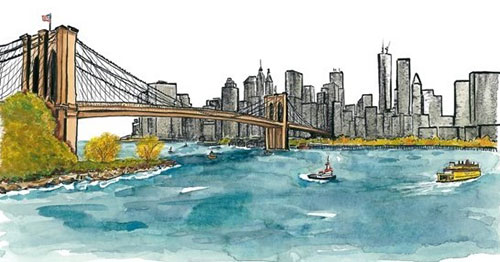
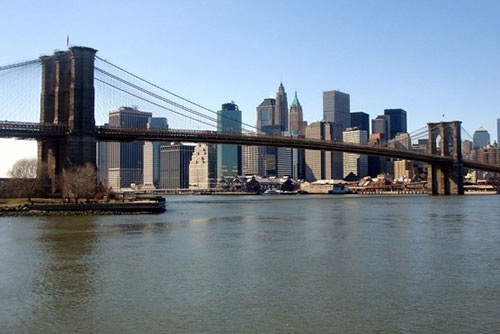
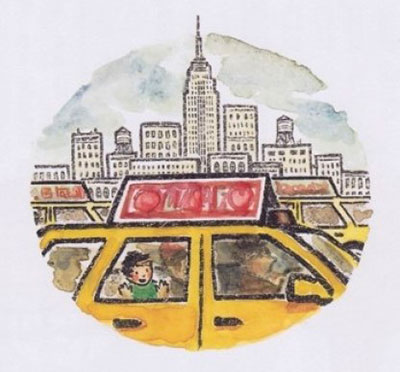
from Nana in the City
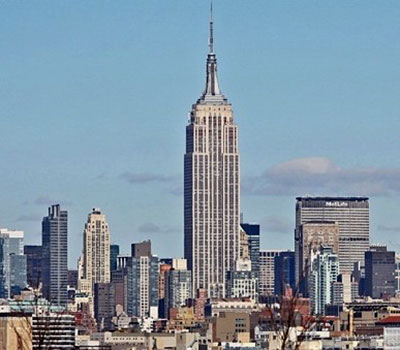
Another famous New York City bridge, the George Washington Bridge, is featured in Tar Beach, a 1992 Caldecott Honor book by Faith Ringgold. Cassie, the 8‑year-old protagonist of the story, considers the bridge her “most prized possession” and wants to “wear it like a giant diamond necklace.” As she explains, her father helped build the bridge, and that places the setting in the late 1930s Harlem where Cassie lives with her family in an apartment building.
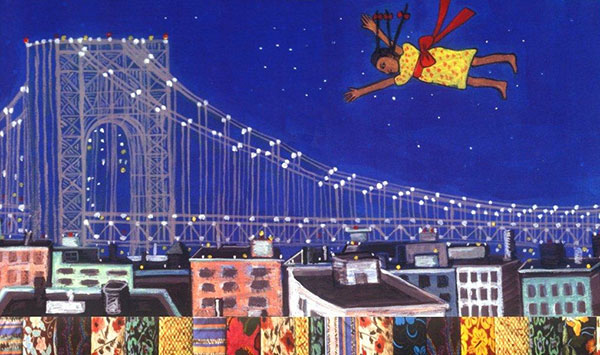
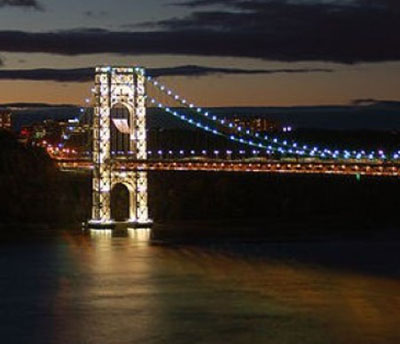
Their “tar beach” roof provides a place for the family to cool off on hot summer nights. The picture book is based on the first story quilt in Ringgold’s “The Woman on the Bridge” series that is part of the permanent collection of the Guggenheim Museum (Spector, 2020), and the text of the story is found near the top and bottom of the quilt. The quilt borders on the bottom of several illustrations in the book add to the folk style of the “acrylic paintings on canvas paper” (ALSC, 2017, p. 117).
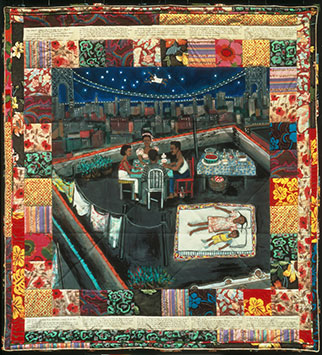
on display at the Guggenheim Museum
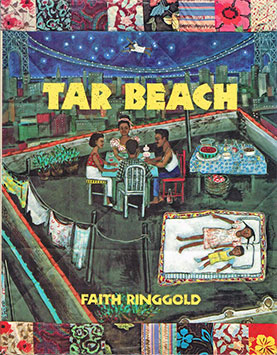
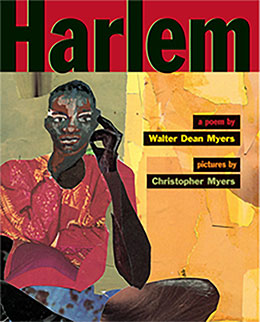 Harlem is also the setting of Walter Dean Myers’ tribute to the neighborhood in which he grew up. His son Christopher Myers illustrates the 1998 Caldecott Honor book Harlem: A Poem using “ink, gouache, and cut-paper collage” (ALSC, 2017, p. 111). The poetry and bold textured images work together to celebrate the culture and history of the people who lived there, and the illustrations also update the neighborhood. Located in Upper Manhattan, the north and south boundaries of Harlem are generally considered West 155th Street and West 110th Street. West 125th Street was renamed Dr. Martin Luther King, Jr. Boulevard in 1984.
Harlem is also the setting of Walter Dean Myers’ tribute to the neighborhood in which he grew up. His son Christopher Myers illustrates the 1998 Caldecott Honor book Harlem: A Poem using “ink, gouache, and cut-paper collage” (ALSC, 2017, p. 111). The poetry and bold textured images work together to celebrate the culture and history of the people who lived there, and the illustrations also update the neighborhood. Located in Upper Manhattan, the north and south boundaries of Harlem are generally considered West 155th Street and West 110th Street. West 125th Street was renamed Dr. Martin Luther King, Jr. Boulevard in 1984.
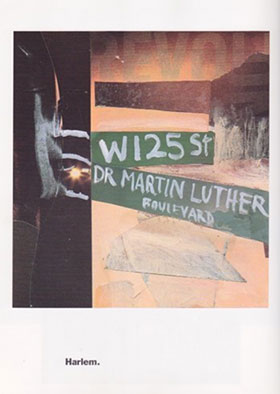
from Harlem, written by Walter Dean Myers
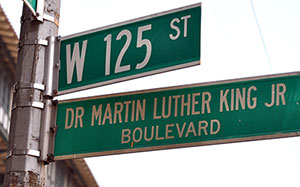
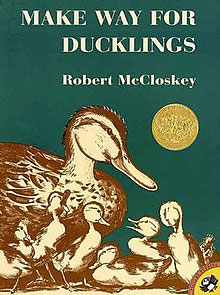 From New York City we proceed north to Boston where Mr. and Mrs. Mallard are searching for a place to build a home in Robert McCloskey’s 1942 Caldecott Medal book Make Way for Ducklings. The Mallard pair fly over Beacon Hill with the State House and Louisburg Square, and finally settle on an island in the Charles River not far from the Public Garden. While living on Beacon Hill as a young man, McCloskey walked through the Public Garden regularly on his way to art school, and he was quite familiar with the architecture of the buildings in the city (Painter, 1968). He created the realistic fluid lines of his art as monochrome lithographs on zinc plates inked in sepia (Marcus, 2012). This brown hue was a close match for the feathers of the mother duck and her babies. Though it may be difficult to see, the license plate on the car in the iconic illustration of the police officer stopping traffic for the duck family to cross the road has a “41” on it. This dates the setting, but it is a timeless story.
From New York City we proceed north to Boston where Mr. and Mrs. Mallard are searching for a place to build a home in Robert McCloskey’s 1942 Caldecott Medal book Make Way for Ducklings. The Mallard pair fly over Beacon Hill with the State House and Louisburg Square, and finally settle on an island in the Charles River not far from the Public Garden. While living on Beacon Hill as a young man, McCloskey walked through the Public Garden regularly on his way to art school, and he was quite familiar with the architecture of the buildings in the city (Painter, 1968). He created the realistic fluid lines of his art as monochrome lithographs on zinc plates inked in sepia (Marcus, 2012). This brown hue was a close match for the feathers of the mother duck and her babies. Though it may be difficult to see, the license plate on the car in the iconic illustration of the police officer stopping traffic for the duck family to cross the road has a “41” on it. This dates the setting, but it is a timeless story.
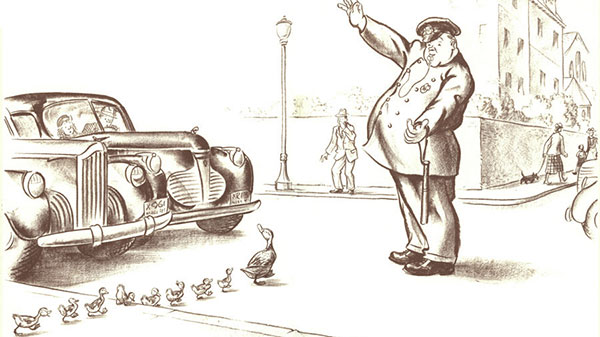
Boston has certainly changed since the 1940s, but the landmarks in McCloskey’s book are still there to visit. McCloskey said Make Way for Ducklings has “…. been an introductory book to Boston for many people” (Marcus, 2012, p. 149). Probably the one place readers of the book visit most is the bronze sculpture of Mrs. Mallard and her eight ducklings created by Nancy Schön with McCloskey’s permission. They stand in the Public Garden near the corner of Beacon and Charles Streets (Isaac, 2004).
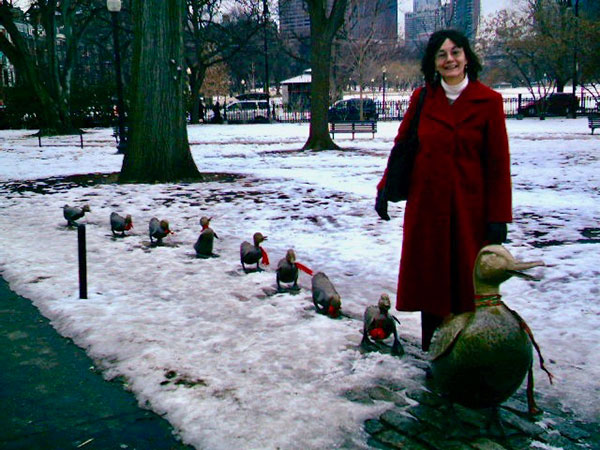
Robert McCloskey and his family lived on their own small island near Deer Isle in Penobscot Bay, Maine during May through September (Painter, 1968). That is the setting of three of his Caldecott Award books: Blueberries for Sal, 1949 Honor; One Morning in Maine, 1953 Honor; and Time of Wonder, 1958 Medal.
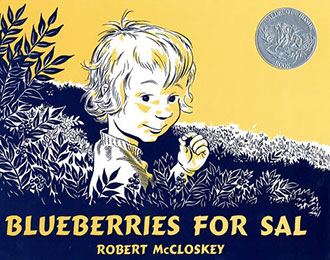
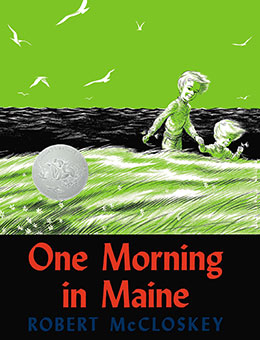
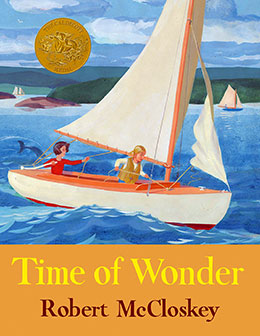
In Blueberries for Sal and One Morning in Maine McCloskey used lithographs as he did for Make Way for Ducklings, but instead of sepia, the ink color is a dark blue, a connection to the water surrounding their island. Time of Wonder is full color done in casein, a water-soluble paint (ALSC, 2017).
These are family stories that feature his own family: his wife Peggy (the storyteller and author Ruth Sawyer’s daughter), his two daughters Sally and Jane, and their pets Penny, an English setter, and Mozzarella, their black cat (Painter, 1968). In One Morning in Maine, father, who looks a lot like Robert McCloskey, rows his daughters to Buck’s Harbor to go shopping for groceries. They stop at Condon’s Garage where Mr. Condon serves the girls ice cream cones. The Condon’s Garage business has since moved up the road, but the building is still there. People like to visit the village of Buck’s Harbor to enjoy the locale of the book (Abby, 2012).
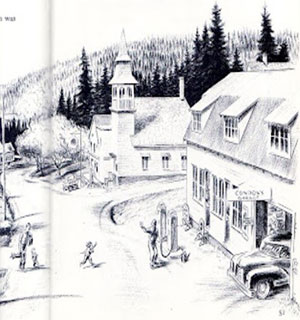
in Buck’s Harbor, Maine, from One Morning in Maine
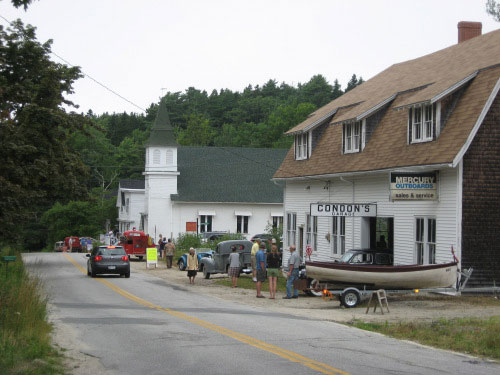
Many illustrators are probably inspired by real locations for their settings. The above illustrators have named or portrayed the settings of their stories so accurately they can be visited and compared to the pictures in the books. Plot them on a map, and you can learn or refresh your geographical skills!
Picture Books Cited
Chin, J. (2017). Grand Canyon. Roaring Brook Press.
Freeman, D. (1957). Fly high, fly low. Viking Press.
McCloskey, R. (1942). Make way for ducklings. Viking.
McCloskey, R. (1949). Blueberries for Sal. Viking.
McCloskey, R. (1953). One morning in Maine. Viking.
McCloskey, R. (1959). Time of wonder. Viking.
Myers, W. D. & Myers, C. (1997). Harlem: A poem. Scholastic.
Politi, L. (1946). Pedro, the angel of Olvera Street. Scribner.
Politi, L. (1948). Juanita. Scribner.
Ringgold, F. (1991). Tar beach. Crown.
Shulevitz, U. (2008). How I learned geography. Farrar, Straus, Giroux.
St. George, J. & Small, D. (2000). So you want to be president? Philomel.
Willems, M. (2004). Knuffle Bunny: A cautionary tale. Hyperion.
Willems, M. (2007). Knuffle Bunny too: A case of mistaken identity. Hyperion.
Photo Images
Abby. (2012). Condon Garage. The Lupine Librarian. https://thelupinelibrarian.wordpress.com/tag/robert-mccloskey/
Bariscale, F. B. (2007). The blessing of the animals. https://www.flickr.com/photos/7294653@N07/1352536281/
De La Cruz, R. (2021). Golden Gate Bridge. https://unsplash.com/@redelacruz
Elisa. (2017). Grand Canyon gatefold. Staff picks. Deerfield Public Library. https://deerfieldlibrary.org/2017/08/staff-picks-grand-canyon/
Global Jet. (2021). NYC icon: Brooklyn Bridge. https://search.creativecommons.org/photos/5dc6e90e-428d-4dcb-ae4b-e2687ca4ed35
Mikul, B. (2021). Empire State Building. https://www.publicdomainpictures.net/en/view-image.php?image=36935&picture=empire-state-building
NYPD 28th Precinct. (2019). W 125 St Dr Martin Luther King Jr Boulevard. Twitter. https://twitter.com/NYPD28Pct/status/1087392989197025281/photo/2
Ringgold, F. (1988). Woman on a Bridge #1 of 5: Tar Beach. Guggenheim Museum. https://www.guggenheim.org/artwork/3719
Southern California Regional Rail Authority. (2021). Modern Olvera Street cross. https://metrolinktrains.com/explore/destinations/olvera-street/
References
Abby. (2012). “One morning in May” day. The Lupine Librarian. https://thelupinelibrarian.wordpress.com/tag/robert-mccloskey/
Association for Library Service to Children (ALSC). (2017). The Newbery and Caldecott Awards: A guide to the medal and honor books. American Library Association.
Bird, B. (2016). Grand Canyon. Calling Caldecott. https://www.hbook.com/?detailStory=grand-canyon
Golden Gate Bridge-Highway & Transportation District. (2021). Bridge features. https://www.goldengate.org/bridge/history-research/bridge-features/color-art-deco-styling/
Marcus, L. (2012). Show me a story!: Why picture books matter: Conversations with 21 of the world most celebrated illustrators. Candlewick Press.
Marple, J. (2014). Illustrator interview – Lauren Castillo. Miss Marple’s Musings. http://joannamarple.com/2014/01/15/illustrator-interview-lauren-castillo/
Painter, H. W. (1968). Robert McCloskey: Master of humorous realism. Elementary English 45(2), 145 – 158.
Riley, P. (2002). Politi, Leo. In A. Silvey (Ed.), The essential guide to children’s books and their creators (p. 362). Houghton Mifflin.
Saxon, A. (2014). Q & A with Lauren Castillo. Publishers Weekly. https://www.publishersweekly.com/pw/by-topic/childrens/childrens-authors/article/62297-q-a-with-lauren-castillo.html
Several, M. (1998). The blessing of the animals: Background information. http://www.publicartinla.com/UnionStation/blessing/blessing.html
Small, D. (2001). Caldecott Medal acceptance. Horn Book Magazine, 77 (4), 411 – 419.
Spector, N. (2020). Faith Ringgold. Woman on a bridge #1 of 5: Tar Beach. Guggenheim Museum. https://www.guggenheim.org/artwork/3719
The Nation’s Report Card. (2018). The NAEP report card: Geography. https://www.nationsreportcard.gov/geography/
Schmitz, T. (2004). Many happy returns. Horn Book Magazine, 80 (4), 477 – 490.
Trausch, J. D. (n.d.). History. Olvera-Street.com. https://www.olvera-street.com/history
United States Government Accountability Office (GAO). (October, 2015). K‑12 education: Most eighth grade students are not proficient in geography. https://www.gao.gov/assets/680/673128.pdf

Thanks for giving us this armchair cross-country tour!